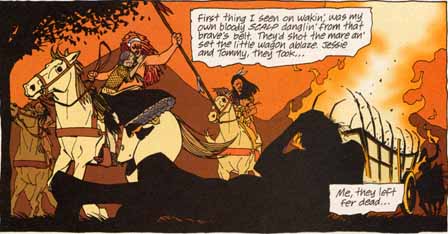Scholar John Sanchez takes his message on the road
By Rick Kearns
“I would like the teachers to walk into their classrooms tomorrow, give the kids some paper and something to draw with, and ask the students to draw a picture of an American Indian family,” Sanchez continued. “I said to not mention the words ‘modern’ or ‘ancient’ just draw a family.”
The result from the second through fifth graders, he explained, was 120 drawings of people in beads and feathers, “with bare-chested men, some with tomahawks, and some had decapitated heads that had been cut with the tomahawks.
“These are 18th century images, and children in second grade have two major ways of knowing things at that age, one is media, and the second is public schools.”
Gee, I wonder where kids got the idea of beheaded Indians. I can't imagine.

I wonder if that was 120 out of 120 drawings. That would be an impressively scary window into what children think.
Note that the drawings didn't just show primitive Indians. They showed primitive Indians decapitating each other. Even though the request was to draw an Indian family. Even though beheadings, if they happened at all, are more than a century out of date.
This would be equivalent to drawing a black family as slaves in chains. Or a Japanese family as samurais and geishas. Or an English family in Victorian-era top hats and corsets.
It would signal a massive amount of stereotypical thinking untouched by our educational system. Imagine the headlines: "Students Perceive Blacks as Slaves." There would be a national outcry.
Yet when the same thing occurs to Indians, we barely notice. Several classes of children think Indians are primitive savages who decapitate each other? Golly, what's wrong with that? Who cares?


Stereotypes and omissions
The article continues:
The majority of that .05 percent used “.… representations of American Indians with 18th century images,” he said.
In any case, consider what Sanchez tells us. During the period in question, Indians were massively underrepresented. Instead of appearing 1% of the time, as their numbers would suggest, they appeared 1/20th as often. They were essentially invisible in the media.
And when they did appear, the appearances were stereotypical a majority of the time. So for every 40 times Indians should've appeared, they appeared only two times. At least one of the two appearances was stereotypical. Real, unstereotypical Indians appeared less than one of 40 times.
Is it any wonder stereotypes dominate our thinking about Indians? And is there any doubt the media is the primary source of these stereotypes? No and no.
For more on the subject, see Students Draw What They Know and Stereotyping by Omission.
Below: Where are Waldo and the Indians?


No comments:
Post a Comment